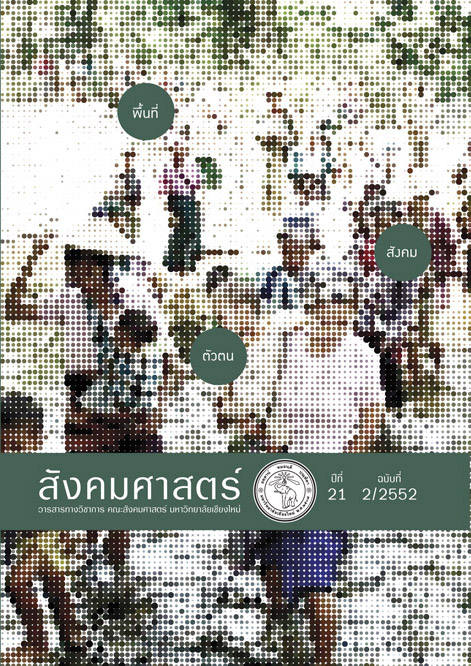Hmong Women Hemp Traders: From Village to Market
Main Article Content
Abstract
This article intends to explain trading relation networks of Hmong women hemp traders, the cores of which are related to the cultural border of Hmong society. This identity of “Hmongness” goes beyond the official demarcation of state borders. Hmong women traders rely on Hmong relations in creating hemp trading networks with Hmong from China, Laos and Thailand. As demand for hemp increased continually, this community’s mode of production changed gradually from agriculture to hemp trading. The process of trading requires that Hmong women travel back and forth from their village in Phayao province to Warorot market in Chiang Mai, which causes different circumstances in terms of power structure and modernity.
The to-and-fro journey between their village and the city has had inevitable impacts on Hmong women’s lives. When Hmong women become traders they are more accustomed and adapted to the public sphere. Such adaptation results in new patterns of relationships. All Hmong women still use men’s structures of relations for trading and opening their social space. In each household, women and men have dynamic interaction and have different contextual conditions. Moreover, women’s power in negotiation, as well as their gender space, roles, and status is fluid.
Article Details
All written articles published on Journal of Social Sciences is its author’s opinion which is not belonged to Faculty of Social Sciences, Chiang Mai University or is not in a responsibility of the journal’s editorial committee’s members.
References
โครงการสร้างฐานเด็กเล็กก่อนวัยเรียนบนที่สูง. 2550. “ประวัติความเป็นมาของชนเผ่าม้ง,”[ระบบออนไลน์]. แหล่งที่มา http://fhhproject.com/hmong.php (2 ตุลาคม 2550).
ประสิทธิ์ ลีปรีชา. 2545. อัตลักษณ์ทางเครือญาติของกลุ่มชาติพันธุ์ม้งท่ามกลางความทันสมัย. ใน ปิ่นแก้ว เหลืองอร่ามศรี (บก.) อัตลักษณ์ ชาติพันธุ์ และความเป็นชายขอบ. (หน้า 203-252), กรุงเทพฯ: ศูนย์มานุษยวิทยาสิรินธร.
ประสิทธิ์ ลีปรีชา. 2546. “เครือญาติข้ามพรมแดนรัฐชาติ: กรณีกลุ่มชาติพันธุ์ม้ง,”วารสารสังคมศาสตร์ คณะสังคมศาสตร์ มหาวิทยาลัยเชียงใหม่, 15(1): 167-186.
สมัย สุทธิธรรม. 2541. สารคดีชีวิตชนกลุ่มน้อยบนดอยสูง แม้ว. กรุงเทพฯ: บริษัท 2020 เวิลด์ มีเดีย จำกัด.
สรัสวดี อ๋องสกุล. 2550. ภาควิชาประวัติศาสตร์ มหาวิทยาลัยเชียงใหม่. รายงานรอส่งพิมพ์เพื่อปรับปรุงเพิ่มเติมในหนังสือ “ประวัติศาสตร์ล้านนา”
อภิญญา เฟื่องฟูสกุล .2543. ““พื้นที่” ในทฤษฎีสังคมศาสตร์”. วารสารสังคมศาสตร์คณะสังคมศาสตร์ มหาวิทยาลัยเชียงใหม่, 12 (2): 65-101.
อรัญญา ศิริผล .2544. “ฝิ่นกับคนม้ง: พลวัตความหลากหลายและความซับซ้อนแห่งอัตลักษณ์ของคนชายขอบ,” วิทยานิพนธ์ศิลปศาสตรมหาบัณฑิต สาขาวิชาการพัฒนาสังคม มหาวิทยาลัยเชียงใหม่.
Donnan, Hastings and Wilson, Thomas (eds.) .1999a. “Introduction : Borders, Nations, and States” in their Borders : Frontiers of Identity Nation and State, Oxford and New York : Berg.
Donnan, Hastings and Wilson, Thomas (eds.) .1999b. “Borders and Boundaries in Anthropology” in their Borders : Frontiers of Identity Nation and State, Oxford and New York : Berg.
Donnelly, Nancy. 1984. “Selling Hmong Textiles” in Changing Lives of Refugee Hmong Women. (pp.88-112), Seattle and London: University of Washington Press.
Geddes, William .1976. Migrants of the Mountains. Oxford: Clarendon Press.
Kandiyoti, Denniz .1999. “Gender, Power and Contestation: Rethinking Bargaining with Patriarchy”, in Cecile Jackson and Ruth Pearson (eds.) Feminist Visions of Development: Gender, Analysis and Policy. (pp.135-
151), London: Routledge.
Kunstadter, Peter .2004. “Hmong Marriage Patterns in Thailand in Relation to Social Change” in Hmong/Miao in Asia. (pp.375-420), Chiang Mai: Silkworm Books.
Massey, Doreen .1994. “Introduction” , in Space, Place and Gender. (pp.177-211),Cambridge: Polity Press.
Pellow, Deborah .2003. “The Architecture of Female Seclusion in West Africa”, in Setha Low and Denise Lawrence-Ziga (eds.) in The Anthropology of Space and Place. (pp.160-184), Oxford: Blackwell Publishing.
Rouse, Roger .2002. “Mexican Migration and the Social Space of Postmodernism” in Jonathan Inda Xavier and Reneto Rosaldo (eds.) The Anthropology of Globalization : A Reader, Oxford : Blackwell Publishers Ltd.
Sahlins, Peter .1998. “State Formation and National \identity In Catalan Borderlands during the Eighteenth and Nineteenth Centuries” in Border Identities : Nation and State at International Frontiers, Cambridge : Cambridge University Press.
Symonds, Patricia .1991. Cosmology and the Cycle of Life: Hmong Views of Birth, Death and Gender in a Mountain Village in Northern Thailand. Rhode Island: Brown University.
การสัมภาษณ์
สัมภาษณ์ กานดา (นามสมมติ) แซ่ลี, อายุ 28 ปี แม่ค้าม้งค้าผ้าใยกัญชง (เก็บข้อมูลช่วงการศึกษาเรื่องการค้าผ้ายกัญชง, มิถุนายน 2549)
สัมภาษณ์ บุญชู พิชิตคีรี, อายุ 82 ปี ผู้ชายม้ง (อดีต) ผู้นำาม้งบ้านเปี่ยมน้ำใจ (เก็บข้อมูลช่วงการศึกษาประวัติศาสตร์ของหมู่บ้าน, มิถุนายน 2549 และมกราคม 2551)
สัมภาษณ์ พรพล (นามสมมติ) มุ่งจันทร์, อายุ 30 ปี ผู้ชายม้งที่มีภรรยาค้าผ้าใยกัญชง(เก็บข้อมูลช่วงการศึกษาเรื่องการค้าผ้าใยกัญชง, มิถุนายน 2549)
สัมภาษณ์ สมพล (นามสมมติ) แซ่หลี, อายุ 38 ปี ผู้ชายม้งที่มีภรรยาค้าผ้าใยกัญชง(เก็บข้อมูลช่วงการศึกษาเรื่องการค้าผ้าใยกัญชง, มิถุนายน 2549)


